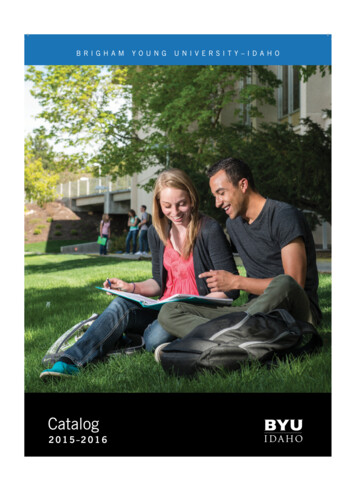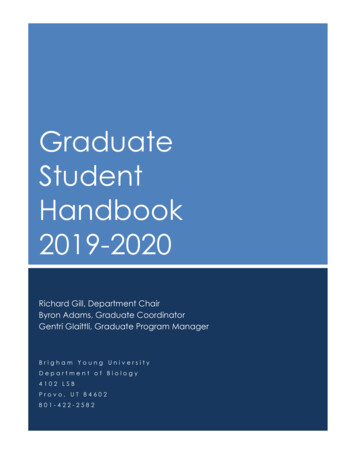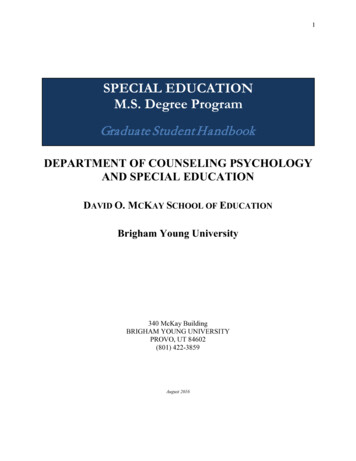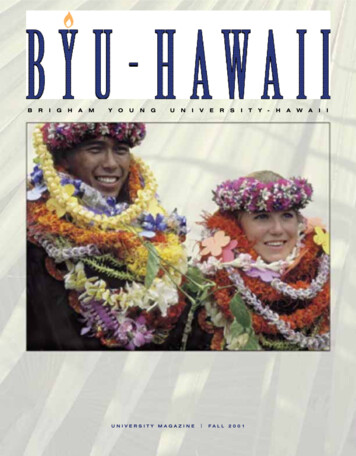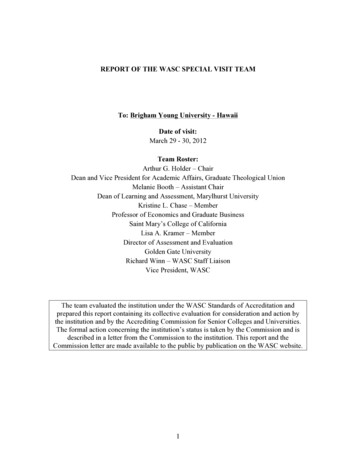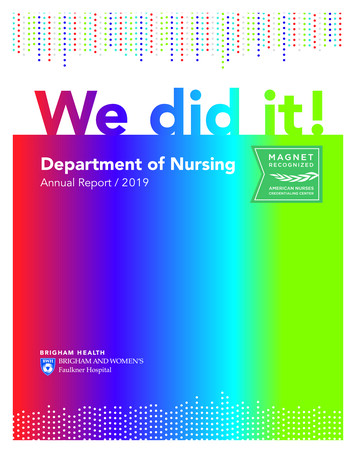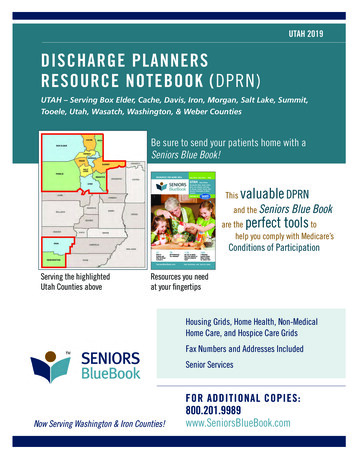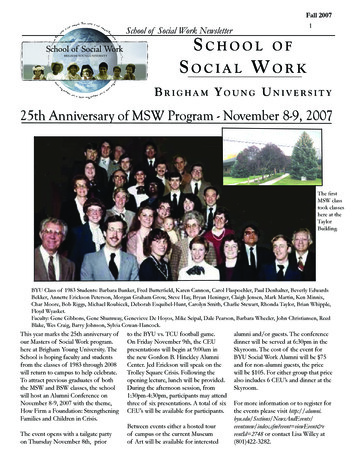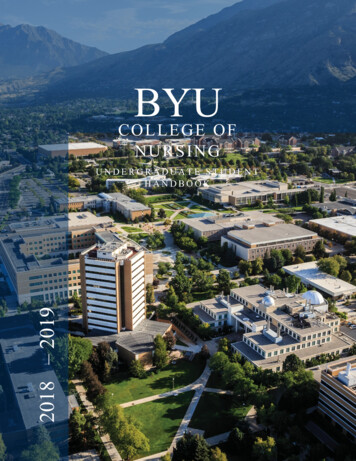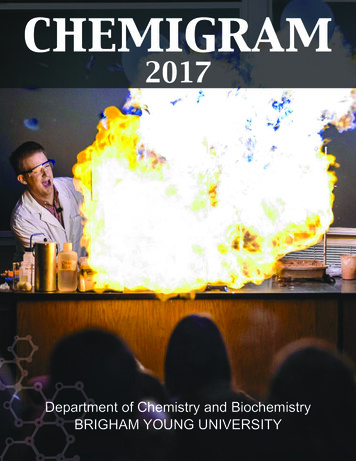
Transcription
chemigram2017Department of Chemistry and BiochemistryBRIGHAM YOUNG UNIVERSITY
LLetter from the ChairThey say time flies when you are having fun. The past year has certainlyflown by quickly, and we are definitely having fun in the Department ofChemistry and Biochemistry. We enjoy teaching undergraduate students,with nearly 12,000 enrollments in our courses during the past year, and withnew developments such as an online version of our introductory chemistrycourse that potentially could let us reach more students. We love teachinggraduate students, with 88 (mostly Ph.D.) students in our program last year.We love doing and publishing our research, virtually all of which involvesour students, bringing in more than 10 million in external grants and giftsto support the work last year despite a generally unfavorable funding climate. We are excited about BYU’s new initiatives in providing experientiallearning opportunities for students because we feel our department has along tradition of excellence in doing chemistry and biochemistry researchwith our students in our laboratories.The past year has also seen a number of changes in our faculty and staff.Professors Dan Simmons and Greg Burton have retired after long and productive careers of service to the university and to science. We express ourthanks to them for jobs well done and we wish them the best as they moveon. Likewise, our newer faculty are making excellent progress. ProfessorJosh Price was promoted to Associate Professor and received continuingfaculty status; Professors Rebecca Sansom and Kara Stowers were both advanced to candidacy for continuing faculty status. We congratulate them onthese achievements.We are also excited to add new faculty members. Professor DanielMortensen joins us from the University of California, Berkeley. He is a massspectrometrist who will oversee our new biological mass spectrometry facility. Professor Pam Van Ry comes to BYU from the University of Nevada, Reno. She is a biochemist who uses mouse models to study musculardystrophy. Professor James Moody received his Ph.D. from the Universityof Washington, followed by postdoctoral work at Montana State. He is abiochemist who uses sophisticated computational techniques to engineerproteins for specific properties such as easy crystallization or for the diagnosis and treatment of disease. We welcome these new faculty membersand look forward to working with them.As you will see in the stories that follow, many exciting things are happening in the BYU Department of Chemistry and Biochemistry. We willcontinue to seek great students and great new faculty members in the coming year.Although changes do present some challenges, overcoming them is partof the fun. It is a great privilege to be associated with the wonderful students, staff, and faculty at BYU. We expect time will continue to fly in thecoming year. Finally, we love hearing from you, so please feel free to get intouch! Contact me at david dearden@byu.edu
CHEMISTRY AND BIOCHEMISTRY2016 AT-A- GLANCEFULFILLING THE MISSION OF BYUDEPARTMENT GOALS/INITIATIVES*Identify, recruit, and retain the best faculty who will fulfill the mission of the universityand achieve the high standards of discipline.*Prepare our students by providing engaging, rigorous classroom instruction.*Provide our students with opportunities to participate in meaningful research projects.*Create a sustainable structure for maintaining and replacing research and teachinginstrumentation.EFFECTIVE TEACHINGStudentStudent Destinations11,864 Students taught28% Graduate School90% service teachingChem 1054.37/5.00Jobs as Chemist orChem 1064.15/5.00BiochemistChem 2854.10/5.0055% Professional School406 Majors5%38% female, 62% maleStudent Ratings - ServiceCourses Taught74 BA or BS graduates6%Teaching ChemistryChem 3514.41/5.0088 Current graduate6%OtherChem 3524.46/5.00students19 PhD, 8 MS Graduates.EXPERIENTIAL LEARNINGMentored Research199 total undergraduates147 majors52 non-majors5Talmage fellows4HS students. 1 personPRODUCTIVE SCHOLARSHIPScholarship130 peer reviewed publications47 with student coauthorBYU External ResearchFundingIn addition, the Department ofChemistry and Biochemistryreceived 5.1 M in gifts forresearchAll other BYU departments-- 33.1 MChemistry &Biochemistry-- 5.3 M
GENEROUS GIFTSNew This YearThe Fritz B. Burns Cancer Research LaboratoryThe Fritz B. Burns Foundation awarded 5 million to Brigham Young University for the establishment of the FritzB. Burns Cancer Research Laboratory. Dr. Joshua L. Andersen, Chemistry and Biochemistry principal investigatorand director of the lab, will oversee the renovation project. The main lab will be located on the second floor, eastwing of the Benson Science Building (BNSN), with a Fusion Lumos Orbitrap mass spectrometer on the first floor.Fritz B. Burns was born in Minneapolis, Minnesota in 1899. He began developing real estate in Los Angeles afterWorld War I, and built so many houses he was known as Mr. Housing. He was the first president of the National Association of Home Builders, and also built, owned, and operated shopping centers and hotels in California and Hawaii. His foundation was established in 1955 to help fulfill his lifelong philanthropic purposes. The foundation hasbeen a longtime supporter of education, medical care, and medical research, among many other charitable causes.The Earl M. Woolley Research Innovation FundAnnounced at Daniel L. Simmons’ retirement dinner, the Earl M. Woolley Research Innovation Fund, establishedthrough the generosity of Dan Simmons, will provide funding for chemistry and biochemistry faculty whose innovative research shows promise. The award name is in recognition of Earl M. Woolley, former department chair, whoprovided financial support to Simmons at an important juncture in his career. Woolley also advised Simmons tohave his COX-2 research findings notarized. This was key in the successful lawsuit brought against PfizerPharmaceutical by BYU.The Bryant E. Rossiter Lectureship SeriesBryant W. and Betty M. Rossiter provided endowed funds for the establishment of the Bryant E. RossiterAnnual Lectureship Series in honor of their son, former BYU Chemistry and Biochemistry faculty member BryantE. Rossiter whose life was cut short by cancer. Shawn Reese, a former student of Dr. Rossiter, paid him tribute, “Dr.Bryant Rossiter was a shining example of a student, scholar, mentor, advocate for students, and made the worldaround him much better because of his generosity of character and spirit. He was an example of servant-leadership,and embodied the type of scientist and person I long to be.”The Hiram and Permelia Dayton ScholarshipWe are pleased to announce the addition of a new department scholarship, The Hiram and Permelia DaytonScholarship. Donated by decendants of Hiram and Permelia Dayton, the scholarship honors two biochemistry students, with one of the awards specified for a female biochemistry major. The Daytons were baptized by the ProphetJoseph Smith in Ohio in 1832. Persecution changed their lives almost immediately, and they joined the saints andtraveled to the Salt Lake Valley, arriving in October 1849. Their faith, devotion, courage, perseverance, and churchservice are commemorated by this award.The D. Clark and Pam Turner Mentored Scholars FundD. Clark Turner, a former BYU chemistry graduate, and his wife, Pam, have established an endowment to specifically fund undergraduate research awards (URAs) for majors in our department. Students are selected from thepool of URA applicants to receive this honor and will correspond with the donors on the progress of their researchduring the award period. Through this endowment, Dr. Turner honors the mentors that assisted him in pursuinghis undergraduate and graduate chemistry degrees at BYU.Many Thanks
GENEROUS DONORSDONORSrepresenting overFORTYscholarships joinedstudents for a luncheonDonors representing over fortyscholarships joined students for aluncheon at the BYU Hinckley Center on Thursday,October 27 to celebrate the importance and blessing ofscholarships in the College of Physical and MathematicalSciences (CPMS). Hosted by CPMS, the luncheon startedwith a greeting by Brent Hall, the college’s LDS Philanthropiesliaison, who emphasized the immense and enduring impactthat scholarships have in students’ lives. “You have all madea difference,” Hall said. “What you’re doing is changing lives,changing families, changing the world. There’s not a personin this room who didn’t have a blessing of a scholarship.” Theluncheon emphasized the theme that scholarships should becontinual and that helping others achieve their dreams is acycle that should never end.Written by Maureen Elinzadno/ Photo by Alyssa LymanAlumni & Friends are Giving Back!You can help. It makes a difference.Click on chemistry.byu.edu/alumni/make-a-donation/ and make a gift to help.100% of your donations go to student support in our department.If you have questions, call Brent Hall at 801-422-4501 or email brent hall@byu.eduBrent is the LDS Philanthropies liaison for the College of Physical and Mathematical Sciences
FACULTY RESEARCHCHIP DESIGN TOMINIMIZE PRETERM BIRTHBYU chemistry professor, AdamWoolley, and BYU chemistry PhDstudent Mukul Sonker, along with BYUpost-docs Radim Knob and Vishal Sahore,created the chipComplications associated with preterm birth are thenumber one cause of death for children under age five,and those who live often face a range of health problems.BYU researchers are hoping to minimize the problemof premature deliveries. The integrated microfluidic device (a palm-sized plastic rectangle with a few pinholes)is designed to predict with up to ninety percent accuracy a woman’s risk for a future preterm birth.“It’s like we’re shrinking a whole laboratory and fittingit into one small microchip,” said BYU chemistry PhDstudent Mukul Sonker, who is the lead author of a studyrecently published in Electrophoresis and funded in partby the National Institutes of Health.The goal for the device is to take a finger-prick’s worthof blood and measure a panel of nine identified pretermbirth biomarkers — essentially biological flags that cantip people off to diseases or other conditions. Therearen’t any current biomarker-based diagnostics forpreterm births and doctors typically only keep tabs onwomen who have other clear risk factors.For this study, Sonker and senior author Professor Adam Woolley, along with BYU post docs Radim Knoband Vishal Sahore, created the chip and a system for preconcentrating and separating biomarkers on it. That’simportant, explained Sonker, “because when you look at these proteins and peptides, they’re present in such atrace amount, but if you preconcentrate them on the chip, you can get enough of a signal for prediction.”Among other benefits, the device is cheap, small, and fast, "Once fully developed," said Woolley, “it will helpmake detecting biomarkers a simple, automated task.” Some peg the annual costs associated with preterm birthin the United States alone at close to 30 billion, so one clear benefit of such a screening tool," said Woolley, "iseconomic. More significantly," he added, “there are a lot of preterm babies who don’t survive. If we could getthem to survive and thrive it would be a huge gain to society.”Written by Andrea Christensen/ Photo by Nate Edwards( BYU photo)
DR. GREGORY BURTON CONTRIBUTESTO WORLDWIDE RESEARCH FIGHTAGAINST HIV/AIDSBYU biochemistry professor Dr. Gregory F. Burton joins Harvard University and other US institutions in the George Washington University-led BELIEVE CollaboratoryBYU is teaming up with George Washington University, Harvard University, Johns Hopkins University,Simon Fraser University in Canada, the University ofSão Paulo in Brazil, and the Children’s National HealthSystem to fight HIV/AIDS. George WashingtonUniversity received a 28 million Martin DelaneyCollaboratory Grant and the “Bench to Bed EnhancedLymphocyte Infusions to Engineer Viral Eradication”(BELIEVE) grant awarded by the National Institutes ofHealth (NIH).a biomedical engineering company that found a way toattach drugs to cytotoxic T-cells which are lymphocytesthat can kill virus-infected cells.One graduate student and two undergraduate students will help Burton with his research for BELIEVE.“While performing research with knowledgeable colleagues is one significant aspect of this grant, teachingstudents is also equally important,” said Burton.BYU Joins Worldwide Researchto Fight Against HIV/AIDSWritten by Taelin Wilford/ Photo by BYU Photo"THE RESEARCH WILL FOCUS ON AN INNOVATIVE CELL THERAPY APPROACH THATCONCENTRATES ON MAKING INDIVIDUALS’IMMUNE SYSTEMS WORK BETTER BY ELIMINATING HIV RESERVOIRS."“[BYU’s] goals are to look at a very specific reservoircalled the follicular dendritic cell (FDC) to determinewhether or not the therapy that is being designed andimplemented is capable of both attacking this reservoir,and targeting those sites and decreasing the amount ofvirus that’s there,” said Dr. Gregory F. Burton.Burton is specifically working with M.D. Connick,the head of infectious diseases at the University ofArizona, and will partner with Altor BioscienceCorporation whose cancer drug candidate ALT-803has been found to enhance the ability of the immunesystem to kill HIV-infected T-lymphocytes, or T-cells.The researchers will also partner with Torque,Written by Taelin Wilford/ Photoby BYU photo
CRASHTESTINGBACTERIABYU chemistry Professor Daniel Austinand his graduate students try to find fatallimitBYU chemistry professor Daniel Austin and hisgraduate students, funded by NASA, are studying thehigh velocity impact of bacterial spores. More specifically, the group is trying to find the speed limit abovewhich bacteria won’t survive when they crash into ahard surface.“There should be a velocity at which they’ll splat anddie but we haven’t reached it,” Austin said.“WE CAN GET PRETTY CLOSE TO THE SPEED OFSOUND, AND WE’RE PLANNING TO GO TO HIGHER VELOCITIES IN THE NEAR FUTURE, BUT IT’SNOT EASY TO DO.”The group’s recently published study in Planetaryand Space Science is the first of its kind to test the impact survivability rate of bare bacteria.Although the main focus of the research is answering the question of how much force the bacteria canwithstand, NASA has funded the research because ofthe planetary protection implications of the study: ifbacteria can survive the ejection from one planet andthe impact of landing on another planet, there are potential concerns about cross contamination of bacteriabetween those planets. However, Austin is quick toacknowledge that there are other factors, like UV light,that may kill the bacteria in transition.“We seem so frequently surprised at what bacteriacan survive, and this just adds to the list,” Austin said.“Our understanding of the limits of life have expandeda lot since the 1970s as we find bacteria surviving andeven thriving under extreme conditions.”Austin’s team has additionally observed an unusualelasticity of the bacterial spores, which may have potential applications in nanotechnology.Writen by: Taelin Wilford / Photo by BYU Photo
HOW EATING LESS CANSLOW THE AGING PROCESSBYU biochemistry professor JC Price and his fellow researchers observed theconnection between consuming fewer calories and improved lifespanThere’s a multi-billion-dollar industry devoted to products that fightsigns of aging, but moisturizers only go skin deep. Aging occurs deeper— at a cellular level — and scientists have found that eating less can slowthis cellular process. Recent research published in Molecular & CellularProteomics offers one glimpse into how cutting calories impacts aging inside a cell. The researchers found that when ribosomes — the cell’s proteinmakers — slow down, the aging process slows too. The decreased speedlowers production but gives ribosomes extra time to repair themselves.“The ribosome is a very complex machine, sort of like your car, and itperiodically needs maintenance to replace the parts that wear out the fastest,” said senior author JC Price. “When tires wear out, you don’t throwthe whole car away and buy a new one. It’s cheaper to replace the tires.”Calorie restriction has not been tested in humans as an anti-agingstrategy, and the essential message is understanding the importance oftaking care of our bodies.“Food isn’t just material to be burned — it’s a signal that tells our bodyand cells how to respond,” Price said. “We’re getting down to the mechanisms of aging which may help us make more educated decisions aboutwhat we eat.”Written by Brooke Adams/ Photo by Nate EdwardMULTI-INSTITUTION COLLABORATIONDr. Daniel H. Ess and Scott Burt joined a multi-institutioncollaboration to disclose in Science a new catalytic chemicalreactionDepartment of Chemistry and Biochemistry professors Dr. Daniel H. Ess and Dr.Scott Burt were part of a multi-institution collaboration to disclose in Science a newcatalytic chemical reaction that replaces hydrocarbon bonds with nitrogen. The collaboration, headed by Professors László Kürti at Rice University and John Falck at theUniversity of Texas Southwestern Medical Center, developed a one-step reaction toconvert arene hydrocarbons to aryl amines which are key molecular precursors for thepreparation of drugs and bioactive molecules. The team’s success achieves a previouslyelusive synthetic chemistry goal.For Dr. Ess, this is his group’s third contribution to a Science publication in justthree years. In 2014, the same team explored the molecular details of directly synthesizing aziridine compounds from alkenes and played a major role in discovering thatmain-group metal compounds facilitate C-H activation chemistry en route to oxygenfunctionalization of light alkanes found in natural gas. The success of the Ess Group isthe result of using and developing powerful state-of-the-art computational chemistrytechniques to reveal the molecular details of complex reactions that propel teams todiscover new catalysts.Writen by: Taelin Wilford / Photo by BYU Photo
Department AnnouncementsSELECTED UNDERGRADUATEEdward PimentelMentored by Professor Merritt B. AndrusThe Fall 2016 Undergraduate Research Award allowed me to makesignificant progress towards the synthesis of my kidney cancer drugtarget. I completed a novel Michael Addition reaction that is one ofthe two key steps of my synthetic pathway, and fully characterizedthe product. I also began work on several different procedures forthe completion of the next key step, a radical cyclization using samarium metal. This progress gives me hope that I’ll soon be ableto submit my product for testing against kidney cancer cells. Thiswork was significant to me because it was the first time I had eversuccessfully run a novel chemical reaction, and I learned that I needto be persistent and to be a problem-solver to push novel researchforward. It also allowed me to focus my attention on my research,which has helped me to support my family and has driven me tolearn to be more effective and efficient in the laboratory.Katherine CollinsMentored by Professor Rebecca L. SansomThis semester I did chemistry education research for Dr. RebeccaSansom. We have been researching the reasoning patterns undergraduate students use when interpreting experimental observationsin an effort to design laboratory experiments that will allow studentsto make connections between submicroscopic, macroscopic, andsymbolic levels of representation and thereby increase their overallunderstanding of chemical concepts. The majority of this semesterwas spent interpreting the data we collected last semester and writing an article to submit to Chemistry Education Research and Practice. The experiences I had with Dr. Sansom this semester have beeninvaluable. I was able to expand my knowledge of the research process from simply performing experiments to analysis interpretationand effective reporting of data. I had the opportunity to write part ofthe paper we are submitting which allowed me to develop a skill thatI will use the rest of my life in both my future schooling and career.This mentored research experience has provided me with opportunities that I wouldn’t have had anywhere else and I am extremelygrateful that I was able to participate in such a wonderful program.
RESEARCHMercede EricksonMentored by Professor Paul B. FarnsworthMy research project images mouse brains using DesorptionElectroSpray Ionization (DESI), coupled with a mass spectrometer.This allows us to trace lipid turnover rates in different structures ofthe brain. One component of the research is the 5% deuterated water diet that incorporates deuterium into the lipids. We monitor thechange in isotope patterns of each lipid at different levels of deuterium incorporation. Our most recent results include creating imagesof spatially regulated lipid metabolism in mouse brain slices, and themonitoring of metabolic pathways for four main lipids, discoveringthat turnover rates vary between lipids and in relation to differentbrain structures. Lipid metabolism is important for understandingvarious diseases such as cancer and neurodegeneration, so our current focus is applying our DESI-MS technique to an Alzheimer’s diseased mouse brain model to see if there’s any significant variation inlipid metabolism compared to healthy control brains.Logan LarsenMentored by Professor Joshua L. AndersenThe project I worked on over the semester was centered aroundthe protein TNK1. TNK1 is suspected to be a cancer promoter whenpresent. We did research to determine where exactly TNK1 binds tothe 14-3-3z protein, which would allow it to promote the spread andgrowth of cancer cells. While narrowing down the region that thebinding site would be found, we made an interesting discovery. Wedid a C-terminal deletion, removing just the end part of the proteinand saw something interesting happen. Removing the C-terminalmakes binding to TNK1 more prevalent. This led us to believe thateither there is some sort of inhibitor of TNK1 in the C-terminal orthe C-terminal is folded over onto an active binding site on the protein. There is a lot more we can do to understand how and why thishappens. Looking forward, we can analyze the crystal structure andlearn more about what is really occurring in the C-terminal. If we areto understand it more, we can potentially inhibit binding to TNK1even more.
ANNUAL LECTURESHIPSBryant E. Rossiter Lecture:Adam CohenDr. Jeremy Johnson introduced Dr. Adam Cohen, the inaugural guest lecturer for the newly-established Bryant E. Rossiter lecture series and shared someinsights, both inspiring and humorous, from Dr. Rossiter’s career as professor inthe Department of Chemistry and Biochemistry from 1985-1994. In honor ofDr. Rossiter, whose life was prematurely cut short by cancer, this lectureship willhighlight early-career principal investigators whose research is promising andclearly on an upward trajectory.Cohen's first talk, "Bringing Bioelectricity to Light," focused on the photochemistry of microbial rhodopsins, and some applications to unusual bioelectrical systems.In his second talk, "Studying Function in Rodent and Human Neurons,"Cohen describes how he has used all-optical electrophysiology to study neuralfunction in primary neurons in vitro. This groundbreaking research providesinsights into diseases such as pain, epilepsy, and ALS.Izatt-Christensen Lecture:R. Graham CooksDr. R. Graham Cooks, one of the world’s foremost experts on mass spectrometryand a distinguished professor at Purdue University, presented the ninth annualReed M. Izatt and James J. Christensen Lecture at BYU, March 20-21, 2017.Cooks graduated with a PhD from the University of Natal in South Africa in1965 and earned another PhD at Cambridge University in 1967. His studies havecovered all aspects of mass spectrometry: research, instrumentation, and analyticalapplications.Cooks’s first presentation, “Mass Spectrometry (MS): Synthesis and Analysis forthe Greater Good,” summarized what mass spectrometry is—the science of analyzing ions to identify and quantify molecules in a mixture—and how the science haschanged over time. He then gave examples of mass spectrometry’s applications infood safety, forensics, drug screening, and brain cancer diagnostics.His second presentation, “Mass Spectrometry (MS): Instrumentation and Chemistry,” delved deeper into how mass spectrometry can be thought of as a method of synthesis—the formation of a chemicalcompound made from two simpler compounds or elements. Cooks emphasized the hope that chemists will someday beable to use mass spectrometry without a vacuum.Photo by Cassie PrettymanIzatt-Christensen Faculty Excellence in Research: Barry M. WillardsonThe 2016 Reed M. Izatt and James J. Christensen Faculty Excellence in Research Awardwas presented to Barry M. Willardson. Dr. Willardson gave a seminar titled, "Mechanisms ofAssembly of Signaling Complexes."Summarizing his research, Dr. Willardson explained, "Cells recognize and respond tophysiological stimuli in a process called cell signaling. This process requires intricate cellularmachinery made from proteins on the cell surface and in the cell interior."Dr. Willardson’s collaborative research with the lab of Jose M. Valpuesta at the Centro National de Biotecnologia in Madrid, Spain, focuses on determining the ways the cell assemblessignaling machinery from their component proteins.Dr. Willardson’s current work is to determine the molecular mechanism of chaperone-mediated assembly of two important signaling complexes, the G protein heterotrimer and themTOR oligomer.
NEW FACESnew faculty membersDr. Pam Van RyDr. Pam M. Van Ry, who joined the department faculty on July 1, 2017, earned her undergraduate degree from the University of Nevada, graduating with a Bachelor of ScienceChemistry degree. In 2014, Van Ry earned her PhD from the University of Nevada, Renowhere she received her degree in cellular and molecular pharmacology and physiology.During her doctoral and postdoctoral studies, she studied protein therapeutics for muscular dystrophy at the University of Nevada School of Medicine. When asked why she wentinto her chosen field of study she said, "I love the translation nature of the work I was ableto participate in. Meeting patients and realizing the work we do in the lab can translate intomeaningful quality of life changes for these patients is amazing, BYU offers an amazingopportunity to work in an incredibly collaborative environment where I can share my loveof science, research, and the gospel.” Pam and her husband, Kevin love to fly fish togetherand look forward to exploring all the rivers and lakes in the area.Dr. James MoodyJames Moody completed his undergraduate studies at Brigham Young University. Hetook a molecular biology course in the College of Life Sciences. In the textbook, he sawhis first protein, a ribbon diagram of a DNA binding protein. As a kid, all he ever wantedfor Christmas or birthdays were Legos. Once he learned about proteins, he knew that hewanted to engineer proteins to solve biological problems in the same way you might buildsomething out of Legos. In graduate school he studied computational protein design at theUniversity of Washington. Then at Montana State University, he studied radical SAM enzymology and protein crystallography. In the middle of all of this, his wife, Amelia and he hadtwo daughters, Genevieve and Giselle. When he is not doing protein engineering, he enjoysspending time with his family, singing, drawing, running, hiking, camping, and playingwith Legos with his daughters. Dr. Moody will be joining the department on August 1st.Dr. Daniel Mortensen Dr. Daniel N. Mortensen earned his undergraduate degree from BYU, where he researchedwith Dr. David V. Dearden using mass spectrometry to study pumpkin-shaped moleculesknown as cucurbiturils that have potential applications in selective drug delivery. He graduated in April 2011 with a BS in chemistry and then headed to the University of California,Berkeley for his doctoral studies. After Dr. Mortensen earned his PhD in 2016, he secured apostdoctoral position here at BYU. In March 2017, Dr. Mortensen began his newly-offeredfaculty position. We welcome Daniel Mortensen and his family. Dr. Mortensen is running anew Biological Mass Spectrometry and Cell Sorting Core Facility in the department, whereresearchers can have their samples analyzed for things such as protein or metabolite content.new staff membersNicole CuthbertAssistant to the ChairsTodd FluckigerStockroom ReceivingManager
DEPARTMENT NEWSEmeritus NewsDr. Milton Lee Awarded the “Chromatographic Society of India Lifetime Contribution Award”Dr. Milton Lee, Professor Emeritus, was honored with the Chromatographic Society of India (CSI) Lifetime Contribution Award for his contributions to developing various chromatographic techniques and for his research and applicationsin SFC technique.This award was presented at the CSI International symposium on the Recent Development in Chromatography and MassSpectrometry that was held at the Institute of Chemical Technology, Mumbai, India on 18-19 November, 2016. ProfessorLee gave two talks at the symposium entitled “Super-critical Fluid Chromatography” and “Novel Chromatographic andMass Spectrometric Instrumentation: From Concept to Commercialization.”Written by Taelin Wilford/Photo by Abhijit GhoshAlumni NewsBYU Alumnus Joseph M. Cardon, a current graduatestudent at UC Irvine, receives an NSF Graduate ResearchFellowshipThe NSF Graduate Research Fellowship Program recognizes and supports outstanding graduate students in NSF-supported science, technology,engineering, and mathematics disciplines who are pursuing research-basedmaster’s and doctoral degrees at accredited United States instituti
28% Graduate School 55% Professional School 5% Jobs as Chemist or Biochemist 6% Teaching Chemistry 6% Other Student Ratings - Service Courses Taught Chem 105 4.37/5.00 Chem 106 4.15/5.00 Chem 285 4.10/5.00 Chem 351 4.41/5.00 Chem 352 4.46/5.00 Mentored Research 199 total undergraduates
